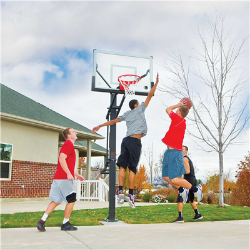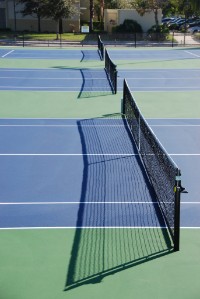Numbers Don't Lie: Chances Of Scoring A Goal In Sports
by Black Ink Team
This scientific article will use mathematics to demonstrate your likelihood of scoring a goal whilst playing a litany of sports. (Sidebar: we will not endeavor to discover your true, objective potential for making your team happy, by arduously modelling how your athletic performance stacks up against the given peers you would face. Rather, we will be providing a rule-of-thumb statistic for each sport that will be factually derived from the size of the goal and the size of the object you want to get into it.) The formula we will be deploying for this study is this: take the size of the goal, take the size of the ball, make a hypothetical 'square ball' based on the diameter of the ball, and see how many square balls can fit inside the confines of the goal. This will produce a whole number which will tell us once and for all how many chances you have of scoring a goal, for a specific sport. Without any further ado, here are the fruits of our research:
Soccer

Scoremaster's Movable Regulation Soccer Goals
Soccer, the American term for football (and not to be confused with American football), is played using a spherical ball and a set of rectangular goals. (Truthfully, the ball is a truncated icosahedron, but for research purposes we will pretend it is a sphere....) A regulation soccer ball has a diameter of 8.65 inches. Regulation soccer goals (or 'nets') have an opening that is 24 by 8 feet. You can stack three-hundred-and-sixty-three soccer balls inside the opening of a soccer net, in a wall that's eleven soccer balls high and thirty-three soccer balls wide - meaning you have 363 finite chances to score in a game of soccer.
Basketball

Lifetime's In-Ground Basketball Hoop
Basketball was created by a gym teacher as a safer alternative to football, but quickly grew to be a sport in its own right. It is played with a legitimate sphere - a basketball. At either end of the 'court' it is played on, there is a 'hoop' (which is exactly what it sounds like). Regulation basketballs have a diameter of 9.39 inches. Regulation basketball hoops (or 'rims') have a diameter of 18 inches. If you have been paying attention, you would have already rightly deduced that this gives you a single logical chance to score throughout the course of a single basketball game. But, if we suppose that you could save face by at least hitting the 'backboard' - a vertical piece of glass which magnanimously helps players make basketballs in - what are your chances then, you ask? Well, regulation backboards are 72 by 42 inches. Without bleeding over, you could glue twenty-eight basketballs to a backboard in a seven-by-four basketballs rectangle, which grants you with 28 whole chances to look like you aren't completely worthless as a teammate in basketball.
Volleyball

United Volleyball Supply's Carbon Fiber Volleyball System
In volleyball, teams can be rewarded a point (for research purposes, we are assuming 'point' is equal in meaning to 'goal') in two ways: one of their players hits the ball from their side of the playing area onto the opposing side's at which point the opposing team fails to return, or one of the opposing team's players hits the ball out-of-bounds or onto their own side of the playing area. The amount of space that is out-of-bounds during volleyball play is seemingly infinite, so you have infinity numerical chances to hand a point over to the oppositional team. So, be careful. The official boundaries of play in regulation volleyball are fifty-nine by twenty-nine-point-five feet - so one team's side is 29.5 by 29.5 feet. A regulation volleyball is 8.15 inches in diameter. You can place a forty-three-by-forty-three square of square volleyballs on one side of a regulation volleyball court, without going over bounds, which gives you 1,849 arithmetic chances to score a point during a volleyball game.
Tennis

10-S Tennis Supply's Courtmaster Net Post Set
Tennis is the exact same as volleyball, except it is played 'mano a mano.' It is played on a court that is seventy-eight-by-twenty-seven feet, so one side is 39 by 27 feet. The diameter of a regulation tennis ball is 2.7 inches. You can arrange twenty-thousand-seven-hundred-and-sixty tennis balls into a one-hundred-and-seventy-three-by-one-hundred-and-twenty tennis balls rectangle on one side of a regulation tennis court, giving you precisely 20,760 chances to score in tennis. (There isn't a word for a singular point scored in tennis, because the scoring system is ridiculously over-complicated.)
Hockey

xHockeyProducts' Official NHL Regulation Goal
Since hockey isn't played with a ball in any way shape or form - it is instead played with a 'puck' - we must offer our research findings in two formats. The two formats will be called the 'gentlemanly' and the 'roguish' - a gentleman hockey player keeps the puck on the ice at all times, whereas a rogue one hits the puck into the air all willy-nilly. Standard hockey goals/nets are 72 by 48 inches. Regulation hockey pucks are 1 inch high and 3 inches wide. If you are to be a gentleman, you'll have 24 chivalrous chances to score a decent goal - you can fit a line of twenty-four pucks in a net. Otherwise, if you are to succumb to rascally means, you'll then have 384 dastardly chances to score - three-hundred-and-eighty-four pucks can be stacked in the opening of a hockey net, in a twenty-four-by-sixteen pucks rectangle.
Lacrosse

CrankShooter's Lacrosse Goal
Lacrosse was first played by Native American Indians, and was originally called 'stickball.' It is played with a rubber ball that has a diameter of 2.5 inches and nets that are 6 by 6 feet. You can stack seven-hundred-and-eighty-four lacrosse balls in a lacrosse net, in a square wall that's twenty-eight-by-twenty-eight lacrosse balls. So, you have 784 algebraic chances to score a goal in lacrosse.
